|
|
the great wall of china (kubur terpanjang di bumi)!!
[Copy link]
|
|
|
Originally posted by nhuser at 13-12-2008 11:25 AM 
My Chinese friend from China said that all Chinese need to go climb the Great Wall and visit Mao Tse Tung's body before they die'
or else??? |
|
|
|
|
|
|
|
|
|
|
|
Reply #21 amazed's post
|
or else..mati macam tak complete lah gitu...like us muslims pergi mecca for pilgrimage (bila mampu, sekali seumur hidup kalau boleh) |
|
|
|
|
|
|
|
|
|
|
|
Originally posted by amazed at 13-12-2008 09:16 AM 
mana lagi tempat ko penah pegi??? bley share informasi gak... kat tempat2 bersejarah ni 
kt china ke??
aku pegi forbiden city....time tu dahla sesak gila...lam tu memang besaq gila.....lepas kuar dr gate 1,ada lagi...dah la masa sampai kt china,kitorang xleh nk check in lagi..trus g forbiden city...ngan lapaq.....jalan trussss ja....ngan lapaq..bila dah kuaq dr tempat tu,kena jln kaki plak nk g kt bus....fuhhhh.....
pas2,2nd day pegi summer palace...pon besaq gedabak.....tasik pon dah besaq....pon x larat nk jalan....ada lorong yg panjang....sepanjang lorong tu ada lukisan....
cuma x pegi tera cota army ja..jauh gak la nk pegi kalo dr beijing.....
nanti aku upload gambo... |
|
|
|
|
|
|
|
|
|
|
|
|
sebenarnya tembok besar yang lama dah hancur atau struktur macam dari tanah liat... yang tinggal cuma dari zaman dinasti ming |
|
|
|
|
|
|
|
|
|
|
|
Reply #11 tosei's post
my boss ada pergi 3 tahun lepas. dia citer ada couple melayu ni, dengan isterinya ngandung 4 bulan selamber naik atas tu. giler ah.
mcm syok jer pergi situ... |
|
|
|
|
|
|
|
|
|
|
|
China's Great Wall is longer than thought
BEIJING (AP): The Great Wall of China is even greater than once thought. A two-year government mapping study has uncovered new sections of the ancient Chinese monument that total about 180 miles (290 kilometers), according to a report posted on the State Bureau of Surveying and Mapping Web site.
Using mapping technologies such as infrared range finders and GPS devices, experts discovered portions of the wall - concealed by hills, trenches and rivers - that stretch from Hu Mountain in northern Liaoning province to Jiayu Pass in western Gansu province, the official China Daily reported Monday.
The newly mapped parts of the wall were built during the Ming Dynasy (1368-1644) to protect against northern invaders and were submerged over time by sandstorms that moved across the arid region, the study said.
The additional parts mean the Great Wall - which Chinese emperors began constructing 2,000 years ago to keep out Monguls and invaders - spans about 3,900 miles (6,300 kilometers) through the northern part of the country.
The joint project, conducted by the State Administration of Cultural Heritage and State Bureau of Surveying and Mapping, will continue for another year in order to map sections of the wall built during the Qin (221 B.C.-206 B.C.) and Han (206 B.C.-9 A.D.) Dynasties, the report said.
Recent studies by Chinese archaeologists have shown that sections of the wall in Gansu are being reduced to "mounds of dirt" by sandstorms and may disappear entirely in 20 years. They blamed destructive farming methods in the 1950s that desertified large areas of northern China. In addition, portions of the wall in Gansu were made of packed earth, which proved less resilient that brick and stone used in much of the wall's construction.
China in recent years has begun restoring parts of the wall as well as trying to rein in commercial development on and around it.
The wall's modern sections around the Chinese capital date from the Ming Dynasty, including those restored since the Communist Party took power in 1949, and several areas - including the most popular, Badaling, just north of Beijing - draw hundreds of thousands of visitors each year.
Tourist encroachment also has been a problem in recent years, with state media saying that near Badaling almost every brick on a popular section of the wall has been carved with people's names or other graffiti. |
|
|
|
|
|
|
|
|
|
|
|
|
Kalau ada tengok filem The Mummy mestilah tau. |
|
|
|
|
|
|
|
|
|
|
|
Kalo rjin, tgk la kat channel 555 (history channel) o 551 (discovery channel). Kalo xsilap bulan lepas o bulan feb ada cite pasal tembok besar cina...
Tembok besar china skrg nei yg masuk utuh dr dinasti Ming sbab guna batu bata. Tembok besar ptama dbuat pd zaman Emperor china pertama, shih huang ti tp mostly da runtuh... |
|
|
|
|
|
|
|
|
|
|
|
|
china ni slalu gak kene gempa bumi, kan? tp x sure area mane yg kene. so, tembok ni xde efek ke? mcm keretakan ke, struktur bawah tanah lari..etc |
|
|
|
|
|
|
|
|
|
|
|
Note: Thread has been banned by manager
|
|
|
|
|
|
|
|
|
|
|
|
Org Nusantara pn ade share kot, dok anta ufti dolu2 ek... |
|
|
|
|
|
|
|
|
|
|
|
ijad_adiputera posted on 10-12-2008 04:45 PM 
aku dah sampai Tembok Besar China nih...
Giler tinggi beb tembok nih... :victory:
hahahha... turun secara duduk yea???.... samala ngn aku.... gila serammmm..... rasa nk terjatuh je bila cuba berdiri n melangkah... last2 mengengsot je la smpai bwh...  ms nak naik pakai overcoat, sweater (cuaca masih sejuk sekitar 12 celcius)... masa nk turun abis bukak segala mak nenek sweater... tggl baju ngn suar je ... panas plak masa menurun..... ms nak naik pakai overcoat, sweater (cuaca masih sejuk sekitar 12 celcius)... masa nk turun abis bukak segala mak nenek sweater... tggl baju ngn suar je ... panas plak masa menurun.....
|
|
|
|
|
|
|
|
|
|
|
|
|
Yang Pelancong Melawat Kebanyakan Tembok Besar zaman Dinasti Ming punya..... |
|
|
|
|
|
|
|
|
|
|
|
The Great Wall of China as a lookout to North Korea
Text and photos by TIFFANY TANMarch 17, 2010 8:28pm
In ancient times, the Chinese people used the Great Wall to keep an eye on their enemies. Now, they’re using it to keep an eye on their allies, at least in Dandong anyway.
Only the Yalu River separates the northeastern Chinese city in Liaoning province from the North Korean mainland, and Dandong capitalizes on a few sites that fuel people’s fascination with its reclusive, headline-grabbing rogue neighbor. According to official figures, Dandong gets 10 million visitors a year – not bad for a third-tier city that is not a familiar destination for many foreigners.
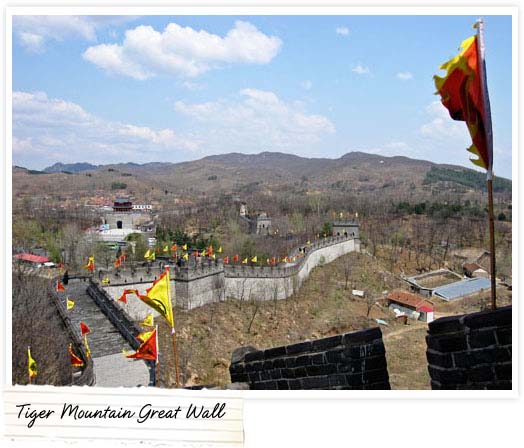
Most tourists flock to a section of the Great Wall that runs parallel to the North Korean border. The Tiger Mountain Great Wall, a 700-meter section of the 7,300-kilometer ancient architectural marvel, is only 20 minutes by car from downtown Dandong.
From the wall (admission 40 RMB or P268), visitors can see a cluster of aging bungalows, people working in the fields, and a few farm animals on the other side of the river. Telescopes may be rented by tourists who want a closer look at the country that rules through an iron fist, and continues to provoke international sanctions because of their nuclear and missile tests.
No first-time visitor leaves Tiger Mountain wall without setting foot on Yibukua – meaning, “ one step across " – an extremely narrow part of the Yalu River. Only chicken wire fences off North Korean territory, so it’s tempting to make the leap across the water. But this is one of the sections of the border where Korean guards are stationed, so old hands caution tourists from approaching the fence even if they think no one is watching.
The relatively uncrowded Tiger Mountain wall has a surreal atmosphere, unlike anything I’ve encountered in other sections of the Great Wall. (I’ve been to four others around Beijing, where I live.) Tiger Mountain seems to draw personalities as peculiar as their desire to “ spy " on the North.
There was the duo of middle-aged men who blasted disco music at one of the towers, encouraging people to dance to stay healthy; the married police officer on his day off who asked my travel companion for a date; and the young mother with her preschool daughter who was at a loss on how to descend the steep wall steps. She finally decided to walk backward to catch the girl if the child fell: a terrible, risky idea to any onlooker with sense.
Ringside seat to history
“ Now I understand why they crossed, " said my companion Du Ping, the granddaughter of a Chinese veteran of the Korean War (1950-53), during a boat ride along the Yalu River. She was talking about the two US journalists detained by the North Koreans in March 2009 and sentenced to 12 years in prison for illegal entry and “ hostilities against the Korean nation. "
The women were captured in Yanji, another Chinese border city further north, while making a documentary about the trafficking of North Korean women to China. Having come this close to North Korea, Du Ping said she could imagine them thinking, “ Maybe we can just have a quick look and then turn back. " The journalists were released in August 2009, during a visit to the North Korean capital of Pyongyang by former US President Bill Clinton.
In some parts of Dandong – like Huangjincao, a North Korean village on the Chinese mainland – the border fence is little more than a year old. Residents say the Chinese government erected the barrier around the time disarmament talks about the North’s nuclear program bogged down in late 2008. China was one of the chief negotiators in the talks along with the US, Russia, Japan and South Korea.
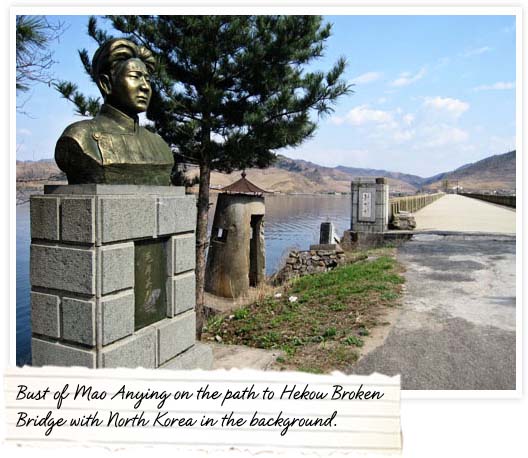
Fifty years ago, the Sino-Korean relationship was all about bridges. It was the Korean War and Peng Dehuai, considered one of modern China’s greatest military commanders, led his troops to the North on what is now called the Hekou Broken Bridge, located 60 kilometers from downtown Dandong.
Among the men in General Peng’s volunteer army was 28-year-old Mao Anying, the eldest son of Mao Zedong, former chairman of the Communist Party of China and leader of the country’s communist revolution. On November 25, 1950, less than five weeks after the soldiers crossed the border, the young Mao was killed in a US bombing raid.
Mao Zedong did not learn of his son’s death until three months later, said former BBC China correspondent Philip Short in his Mao Zedong biography, Mao: A Life. Peng sent Mao a telegram the same day the young man died, “ proposing that he be buried on the battlefield, like all Chinese soldiers in Korea, " Short wrote. Mao’s secretary received the telegram and “telephoned (Premier) Zhou Enlai, who contacted other leaders. They authorized the burial, but decided that, with the war at a critical juncture, Mao should not be told. "
A bust of Anying and China’s other Korean War heroes line the path leading to Hekou Broken Bridge (admission 10 RMB or PhP67), one of the two bridges that used to connect China and North Korea. Hekou bridge was destroyed when the US military strafed it to prevent food and military supplies from reaching the Chinese troops during the war.
Made in North Korea
How do ordinary North Koreans feel about all the scrutiny and the fascination of foreigners with them ? Annoyance, envy, fear, amusement – or resignation ? These questions went around and around my head the whole time I was in Dandong.
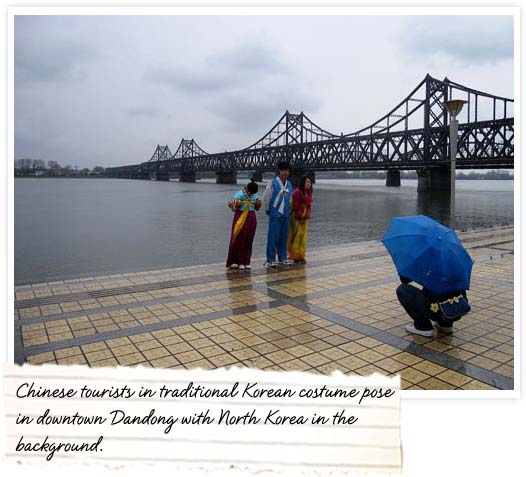
Even Dandong’s souvenir vendors feed on this phenomenon, plying goods “ made in North Korea. " Their stalls are piled high with cigarettes, compact mirrors, animal figurines, chopsticks and North Korean coins and banknotes.
One female vendor said she obtains her goods through barter. In exchange for the items, the North Koreans ask for meat and “ daily necessities, " she said, adding that some of her suppliers had become friends through the years.
Getting there
Air China has daily one-and-a-half-hour flights from Beijing to Dandong.
If you’re not in a rush, an overnight train ride from Beijing is a good way to get a glimpse of China’s northeastern countryside, formerly known as Manchuria. The train’s hard sleeper section (around 250 RMB or PhP 1674 for six people in two three-level bunks) provides basic necessities for a good night’s rest: a pillow, clean sheets and a duvet. Soft sleepers are double the price for a room of not more than four and a mattress.
A taxi from downtown Dandong to Tiger Mountain Great Wall costs 40 RMB. You can also catch a bus from the city’s train station for 2 RMB (PhP13.40).
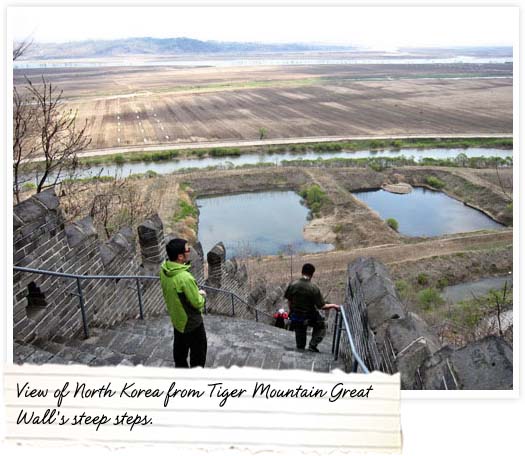
On your way to Tiger Mountain wall’s exit, you’ll come across a family-run eatery, Nongjia Tese Xiaochi. Stop by for a meal if you want to taste real village cooking. It specializes in benji or “ stupid chicken " – stewed chicken with mushrooms – and Yalujiang Heyu, fish from the Yalu River prepared any way you like. The chicken dish takes about an hour to make because family members first have to catch your chicken inside a coop, then sacrifice it in the name of sustenance. The chicken and fish cost 20 RMB (PhP134) for every half a kilo.
The eatery owners, a Manchu family, accept lodgers into their modest home. For 15 RMB a night, a guest gets a spot on their kang, a sleeping platform made of fired clay with a cavity that channels the exhaust from a wood stove to ward off the cold in winter. Behind the house is a makeshift squat toilet, the biggest attraction of which is a view of the Great Wall while you answer the call of nature.
Sources : http://www.gmanetwork.com
|
Rate
-
1
View Rating Log
-
|
|
|
|
|
|
|
|
|
|
|
China’s Great Wall expansion should abide by historical facts
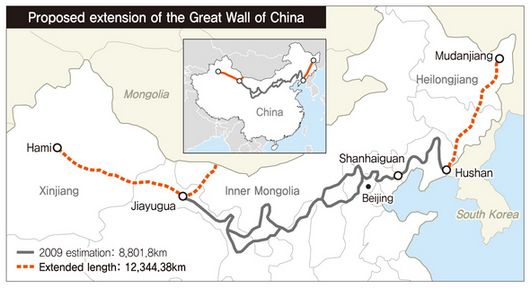
Chinese authorities have more than doubled the length of the Great Wall to include the historically Korean territories of Goguryeo and Balhae. Those two areas were ancient Korean kingdoms that are now located within China and Russia.
According to a report in the Guangming Daily, the official newspaper of the Chinese Communist Party, the country’s State Administration of Cultural Heritage had announced the total length as 21,196.18 kilometers. These findings are based on an archeological survey launched in 2007. By this count, the wall stretches from the westernmost province of Qinghai to the easternmost province of Heilongjiang.
There have been ongoing efforts to extend the wall ever since the State Council issued protective regulation in 2006. As recently as the early 2000s, the prevailing view was that the eastern end was Shanhai Pass in Hebei Province. In 2009, however, authorities included in the Goguryeo fortress of Bakjak (known as Mt. Hushan Fortress in China), which is located in Dandong, Liaoning Province. It held an extravagant ceremony to erect a marker identifying it as the “ eastern terminus of the Great Wall. ” Now, they’re including old Goguryeo and Balhae territories as well.
The significance of this extension is more political than academic. In some sense, this is a symbolic manipulation designed to bolster the notion of China as unified multiethnic state across a vast area including some 56 different ethnic groups, the majority of which are Han Chinese. Indeed, there is a good chance it may have incorporated a number of fortifications from completely different builders and time periods.
But it’s troubling to see the country distorting Korean history to suit its internal political ends. Beijing already stirred up diplomatic friction with Seoul in 2002 when it launched its “ Northeast Project, ” which sought to incorporate the old Korean regions of Gojoseon, Goguryeo, and Balhae into the history of China’s frontiers. The latest announcement, which also claimed huge chunks of Goguryeo and Balhae, only looks more suspicious in light of this.
We hope Beijing will show prudence here and recognize that its state-led efforts to rewrite history could stir up discord with its neighbors. China also needs to understand that this kind of excess from a country that is already the world’s second power will merely make it look rapacious in the eyes of the international community, and could lose the country more than it gains.
For our part, the South Korean government should find out the exact nature of China‘s announcement and demand corrective action on any factual distortions. More fundamentally, we should be conducting research and surveys to establish a solid foundation for preserving our history and legacy.
Sources : http://www.hani.co.kr
|
|
|
|
|
|
|
|
|
|
|
|
nilah Rahsia Kekuatan Tembok Besar China
Inilah Rahsia Kekuatan Tembok Besar China
Rahsia dari kekuatan dan umur panjang Tembok China terletak pada ketan yang digunakan sebagai perekat campuran semen, menurut penemuan sejumlah ilmuwan China.
Dr. Zhang mengatakan penggunaan ketan merupakan salah satu inovasi teknik terbesar pada zaman tersebut.
Para pekerja membangun Tembok Besar pada jaman Dinasti Ming, sekitar 600 tahun silam dengan mencampurkan tepung ketan dengan kapur, sebagai bahan standar campuran perekat, ujar Dr. Zhang Bingjian.
Campuran ketan mengikat batu bata begitu erat banyak rumput liar tidak bisa tumbuh. Namun, penolakan luas terjadi di selatan China terhadap pembangunan Tembok tersebut karena kaisar Ming meminta panen ketan di selatan untuk makanan pekerja dan sebagai campuran semen.
'Campuran perekat semen kuno tersebut, terdiri dari semacam campuran khusus organik dan anorganik,' ujar Dr. Zhang, pakar kimia dari UniversitiZhejiang, kota Hangzhou, China Timur, seperti dilansir Telegraph.
'Komponen organik, amilopektin, berasal dari bubur ketan yang ditambahkan ke dalam campuran semen,' imbuhnya.
'Komponen anorganiknya adalah kalsium karbonat dan komponen organiknya adalah amilopektin yang berasal dari ketan. Amilopektin membantu menciptakan mikrostruktur padat, menjadikan Tembok Besar lebih stabil serta memiliki kekuatan mekanis yang lebih besar,' menurut laporannya dalam jurnal American Chemical Society.
Dr. Zhang mengatakan, penggunaan ketan, bahan makanan pokok Asia Timur, merupakan salah satu inovasi tekhnis terbesar pada saat itu, yang membantu berbagai pusara, pagoda dan tembok pada zaman Dinasti Ming dari hentaman cuaca, gempa bumi serta bencana alam lainnya.

|
|
|
|
|
|
|
|
|
|
|
|
lawanya amoi 
tembok besar apa???  |
|
|
|
|
|
|
|
|
|
| |
|